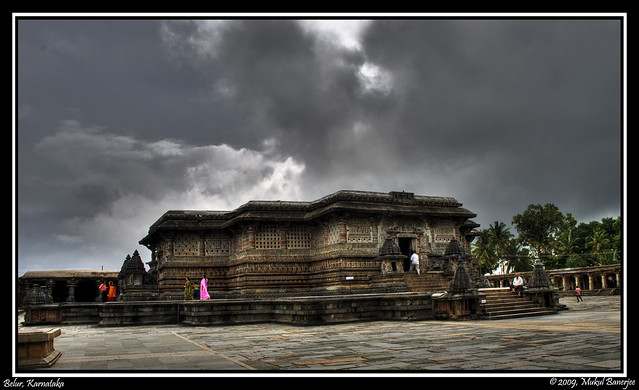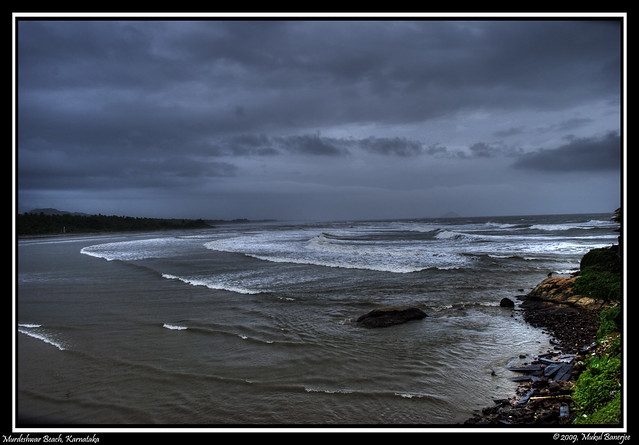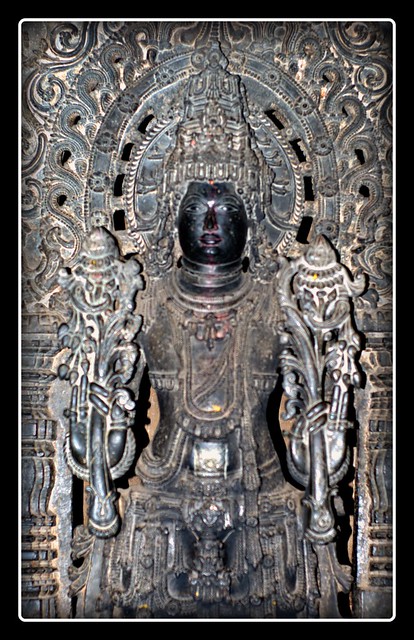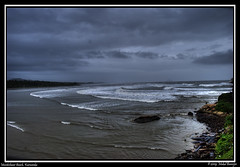Belur, Halebidu, Murdeshwar & Gokarna Trip, July 09
39 fotos

halebidu_pan_1-m

Belur_HDR1
Belur was the early capital of the Hoysala Empire. With Halebidu which is only 16 km away, this is one of the major tourist destinations in Karnataka, India. Belur is located in Hassan district. According to inscriptions discovered here, it was also referred to as Velapuri.
The main attraction in Belur is the Chennakesava temple complex which contains the Chennakesava Temple ( dedicated to Chennakeshava , meaning handsome Vishnu) as the centre piece, surrounded by the Kappe Chennigraya temple built by Shantaladevi, queen of king Vishnuvardhana.
There are two more shrines here that are still in use by devotees and there is a Pushkarni or stepped well to the right side of the main entrance. The Dravida style rayagopuram at the entrance which was a later addition by the Vijayanagar kings, who considered this deity as one of their Kuladevata or family god.
The temple is one of the finest examples of Hoysala architecture. It was built by king Vishnuvardhana in commemoration of his victory over the Cholas at Talakad in 1117 CE. Legend has it that it took 103 years to complete and Vishnuvardhana's grandson Veera Ballala II completed the task. The facade of the temple is filled with intricate sculptures and friezes with no portion left blank. The intricate workmanship includes elephants, lions, horses, episodes from the Indian mythological epics, and sensuous dancers (Shilabalikas). Inside the temple are a number of ornate pillars. Darpana Sundari ( Lady with the mirror ) carved on walls of Belur Temple is one of major attraction in complex.
This temple along with Hoysaleswara temple in Halebidu and the Jaina monuments at Shravanabelagola are being proposed as UNESCO world heritage sites.

Murdeshwar Beach
Murudeshwara temple, dedicated to Lord Shiva, lies in the holy beach town in the Bhatkal Taluk of Uttara Kannada district in the state of Karnataka, India. Situated between the Honnavar and Bhatkal town(about 12kms) The statue of Shiva here is the world's tallest and it lies on the coast of the Arabian Sea.
The Statue of Shiva with Ravana handing Atma Linga to Bramhin boy(Lord Ganesha)
History
The name "Murudeshwara" means Shiva or Eeshwara. The significance of this holy town dates to the time of Ramayana. By penance dedicated to the AtmaLinga, the divine Lingam of Shiva procures invincibility and immortality to the Hindu Gods. Ravana, the Lanka King worshipped Shiva with devotion to attain immortality by obtaining the AtmaLinga. Lord Shiva appeared before Ravana and asked him what he wanted. By this time Lord Vishnu to change Ravana's mind on behest of Narada. As a result of this plot, Ravana asks for Goddess Parvathi, and Lord Shiva offers him.
On his way back to Lanka Narada tricks Ravana that the real Parvathi was in Pathala. So Ravana lets off Parvathi and went to Pathala and marries a king's daughter thinking that she was Parvathi. When he returns back to Lanka his mother then asks for linga. Ravana knowing that he was tricked is angry with Vishnu and meditates to please Lord Shiva.
Lord Shiva appears and Ravana asks for His forgiveness. And this time, Ravana requests the AtmaLinga as his boon. Lord Shiva agreed to give him the boon with a condition that it should never be placed on the ground. It is believed that the AtmaLinga was ever placed on the ground, all the powers would return to Lord Shiva again. Having obtained his boon, Ravana started back on his journey to Lanka.
Sage Narada, realised that with the AtmaLinga, Ravana may obtain immortality and create havoc on earth, approached the Lord Ganesh to help him. As Ravana was nearing Gokarna, Lord Vishnu blocked the sun to make it appear as dusk. Ravana now had to perform his evening rituals but was worried because with the AtmaLinga in his hands, he would not be able to do his rituals. At this time, Lord Ganesh, disguised as a Brahmin boy came near him.
Ravana requested him to hold the AtmaLinga until he performed his puja, and told him not to place it on the ground. Ganesh struck a deal with him saying that he would call Ravana thrice, and if Ravana did not return within that time, he would place the AtmaLinga on the ground.As predicted, before Ravana could return after completing his rituals, Ganesh had already placed the AtmaLinga on the ground. Vishnu then removed his illusion and it was daylight again.
Ravana got really angry that he was tricked and tried to uproot the AtmaLinga and destroy it but could not. In a fit of rage he threw the case covering it to a place called Sajjeshwara, 23 miles away. Then he threw the lid of the case to a placed called Guneshwara (now Gunavanthe)and Dhareshwara, 10-12 miles away. Finally, he threw the cloth covering the AtmaLinga to a placed called Mrideshwara in Kanduka-Giri (Kanduka Hill). Mrideshwara has been renamed to Murudeshwara.

Murdeshwar Beach, Karnataka
Murudeshwara (Kannada: ಮುರುಡೇಶ್ವರ) is a town in the Bhatkal Taluk of Uttara Kannada district in the state of Karnataka, India. "Murudeshwara" is another name of the Hindu god Shiva. Famous for the world's second tallest Shiva statue as the tallest one is nepal being inaugrated on 21st june 2010 by ram baran yadav{president of nepal} and shankracharya jee made by mr. kamal jain. it is called kailashnath mahadev in kailash puri. "Murudeshwara" beach town lies on the coast of the Arabian Sea and is also famous for the Murudeshwara Temple.
The origin of the name "Murudeshwara" dates to the time of Ramayana. The Hindu gods attained immortality and invincibility by worshipping a divine lingam called the AtmaLinga. The Lanka king Ravana wanted to attain immortality by obtaining the AtmaLinga. Since the AtmaLinga belonged to Lord Shiva, Ravana worshipped Shiva with devotion. Pleased by his prayers, Lord Shiva appeared before him and asked him what he wanted. By this time Narada had asked Lord Vishnu to change Ravana's mind. As a result of this plot, Ravana asks for Goddess Parvathi, and Lord Shiva offers her to him. On his way back to Lanka Narada tells Ravana that Lord had not given him the real Parvathi and that the real Parvathi was in Pathala. So Ravana frees his companion,goes to Pathala and marries a king's daughter ,assuming her to be the real Parvathi. He then returns to Lanka, where his mother asks him for the Linga. Ravana then comes to know of the tricks played on him by Lord Vishnu. He therefore prays to Lord Shiva again, begging for his forgiveness. Lord Shiva appears and this time, Ravana requests the AtmaLinga as his boon. Lord Shiva agrees to give him the boon with the condition that it should never be placed on the ground. If the AtmaLinga was ever placed on the ground, all the powers would return to Lord Shiva again. Having obtained his boon, Ravana started back on his journey to Lanka.
Sage Narada, who came to know of this incident, realised that with the AtmaLinga, Ravana may obtain immortality and create havoc on earth. He approached the Lord Ganesh and requested him to prevent the AtmaLinga from reaching Lanka. Lord Ganesh knew that Ravana was a very devoted person who used to perform prayer ritual in the evening every day without fail. He decided to make use of this fact and came up with a plan to confiscate the AtmaLinga from Ravana.
As Ravana was nearing Gokarna, Lord Vishnu blotted out the sun to give the appearance of dusk. Ravana now had to perform his evening rituals but was worried because with the AtmaLinga in his hands, he would not be able to do his rituals. At this time, Lord Ganesh in the disguise of a Brahmin boy accosted him.Ravana requested him to hold the AtmaLinga until he performed his rituals, and asked him not to place it on the ground. Ganesh struck a deal with him saying that he would call Ravana thrice, and if Ravana did not return within that time, he would place the AtmaLinga on the ground.
As predicted, before Ravana could return after completing his rituals, Ganesh had already placed the AtmaLinga on the ground. Vishnu then removed his illusion and it was daylight again. Ravana, realising that he had been tricked,tried to uproot and destroy it; Due to the force exerted by Ravana, some pieces were scattered. One such piece from the head of the linga is said to have fallen in present day Surathkal .The famous Sadashiva temple is said to be built around that piece of linga. Then he decided to destroy the covering of the AtmaLinga, and threw the case covering it to a place called Sajjeshwara, 23 miles away. Then he threw the lid of the case to a placed called Guneshwara (now Gunavanthe)and Dhareshwara, 10–12 miles away. Finally, he threw the cloth covering the AtmaLinga to a placed called Mrideshwara in Kanduka-Giri (Kanduka Hill). Mrideshwara has been renamed to Murudeshwara.

Sculpture, Halebidu
Halebidu is located in Hassan District, Karnataka, India. Halebidu (which was previously called Dorasamudra or Dwarasamudra) was the regal capital of the Hoysala Empire in the 12th century. It is home to one of the best examples of Hoysala architecture in the ornate Hoysaleswara and Kedareswara temples. Halebidu literally means ruined city. This name is given because this city was ruined two times by Bahmani Sultanate.
Halebidu was the 12th century capital of the Hoysalas. The Hoysaleswara temple was built during this time by Ketamala and attributed to Vishnuvardhana, the Hoysala ruler. It enshrines Hoysaleswara and Shantaleswara, named after the temple builder Vishnuvardhana Hoysala and his wife, Queen Shantala.
Then it was sacked by the armies of Malik Kafur in the early 14th century, after which it fell into a state of disrepair and neglect.
The temple complex comprises two Hindu temples, the Hoysaleshawara and Kedareshwara temples and two Jain basadi. In front of these temples there is a big lake. The town gets its name the from the lake, Dwara samudhra which means entrance from ocean[clarification needed]. The two Nandi statues which are on the side of the Hoysaleshwara temple are monolithic. Soap stone or Chloritic Schist was used for the construction of these temples. However a number of sculptures in the temple are destructed by invaders. So the temple is incomplete. Halebid means old abode. There is an archeological museum in the temple complex.
Profile of Hoysaleshwara Temple, Halebidu
The Hoysaleswara temple, dating back to the 1121 C.E., is astounding for its wealth of sculptural details. The walls of the temple are covered with an endless variety of depictions from Hindu mythology, animals, birds and Shilabalikas or dancing figures. Yet no two sculptures of the temple are the same. This magnificent temple guarded by a Nandi Bull was never completed, despite 86 years of labour. The Jain basadi nearby are equally rich in sculptural detail. Belur and Halebid are 222 and 216 km from Bangalore, respectively. This temple is now being proposed as UNESCO World Heritage Site.
| |||
| Accueil |Pensées Du Jour | | Galleries | La Bhagavad-gita Telle Qu'elle Est |
| | Le Cours Ultime de la Réalisation du Soi (tm) | | |
| Obtenez la miséricorde spéciale de Krishna en faisant du service de dévotion Aidez Sankarshan Prabhu dans sa mission de répandre la conscience de Krishna partout dans le monde. Une contribution singulière ou mensuelle peut se faire en ligne en allant ici : | Un appel pour votre assistance Sur l’ordre de son maître spirituel, Srila Prabhupada, Sankarshan Prabhu à dédié sa vie au travail extrêmement urgent de répandre la conscience de Krishna partout dans le monde. Le plus la conscience de Krishna se répand, le plus que la souffrance, le manque et la haine sur cette planète seront remplacés par la félicité, l’abondance et l’amour. Voici une opportunité dorée de faire le plus grand bien pour toutes les entités vivantes et de recevoir les bénédictions spéciales du Seigneur. Par conséquent, nous devons, au mesure du possible, sacrifier notre temps, notre énergie et nos ressources pour aider Sankarshan Prabhu dans son travail urgent. Si vous voulez participer d’une façon ou d’une autre, grande ou petite, veuillez écrire à Sankarshan Prabhu en cliquant si dessous : Envoyer un courriel à Sankarshan Prabhu
| de Sankarshan Prabhu |
Mercredi, le 4 octobre 2006
De Tartou en Lettonie,
« Retrouvant ton identité originelle»
Mon maître spirituel, Srila Prabhupada, m’a donné le plus grand cadeau inconcevable. Il m’a donné le sentier pour gagner rapidement la perfection spirituelle. Il m’a demandé de ne pas garder ce cadeau pour moi tout seul. Il m’a donné l’ordre de le partager gratuitement avec tout le monde. Ainsi, suivant son ordre, ma vie est dédiée à 100% pour t’aider à réveiller la conscience illuminée endormie qui se trouve en toi à chaque instant.
Tu n’es pas fait pour souffrir la répétition des morts et des renaissances. Ta vie humaine est faite pour réanimer ta conscience pure originelle et pour rétablir ton identité originelle dans le monde spirituel. Ton identité originelle est décrite correctement dans le Srimad Bhagavatam comme suit :
yat-sevayagner iva rudra-rodanam
puman vijahyan malam atmanas tamah
bhajeta varnam nijam esa so 'vyayo
bhuyat sa isah paramo guror guruh
« Celui qui veut se libérer de l’embrouillage matériel doit se rendre au service de dévotion à la Personnalité Suprême de Dieu et abandonner la contamination de l’ignorance, des activités pieuses et impies. Ainsi, on regagne son identité originelle, tout comme un morceau d’or ou d’argent se sépare de toute souillure et devient purifié par le traitement du feu. Cette Personnalité Suprême de Dieu, puisse-t-Elle devenir notre maître spirituel, car Il est le maître spirituel originel de tous les autres maîtres spirituels. » Srimad Bhagavatam 8.24.48
Sankarshan Das Adhikari
Réponses selon la version védique :
Question : N’y-a-t-il pas beaucoup de personnes illuminées ?
Aidez-moi à comprendre, s’il vous plait. Comment savons-nous que 99.99% des gens sont perdus et dans un état d’illusion ? Il doit bien y avoir beaucoup de bonnes personnes provenant de diverses cultures, quelles soient Hindoues, Musulmanes, Chrétiennes, etc. N’y-a-t-il donc pas beaucoup de personnes illuminées dans le monde ?
Excusez ma question, mais je ne comprends pas.
Sincèrement,
Votre étudiant
Réponse : Non. Leur nombre est très petit …
La nature déchue des âmes dans l’âge présent de Kali est décrite dans le Srimad Bhagavatam comme suit :
prayenalpayusah sabhya
kalav asmin yuge janah
mandah sumanda-matayo
manda-bhagya hy upadrutah
« O savant! Dans cet âge de fer de Kali, les hommes ne possèdent qu’une courte vie. Ils sont querellant, paresseux, égarés, infortunés et surtout toujours agités. » Srimad Bhagavatam 1.1.10
En remarquant la différence entre la bonté et l’illumination spirituelle, il est facile de discerner que presque tout le monde en dans un état d’illusion. Combiens de journaux illuminés sont distribués et lus ? Combiens de films illuminés font le grand succès au cinéma ? Combiens de livres illuminés sont sur la liste des meilleurs vendus ? Combiens de dirigeants illuminés du gouvernement mènent leurs peuples de telle façon qu’ils deviennent tous illuminés ? Si l’illumination spirituelle était chose commune, il y aurait une remarquable différence dans l’atmosphère du monde. Le monde serait pratiquement libre de toute forme de terrorisme et de crime.
Il y a une profonde différence entre être bon et être illuminé. La qualité de la bonté est connue sous le nom de sattva-guna et elle est la position la plus haute parmi les modes de la nature matérielle. Ceux qui se trouvent dans la modalité de la vertu ou la bonté reprennent naissance à nouveau dans ce monde matériel. Bien qu’ils soient dans une position avantagée pour pouvoir cultiver l’illumination spirituelle, s’ils ne s’y appliquent pas, ils doivent rester dans le cycle des morts et des renaissances.
Ce nombre d’âmes rares qui s’élèvent au niveau de l’illumination spirituelle se situent sur la plateforme nommée suddha-sattva ou bien la bonté pure. Ces âmes sont 100% libres des qualités de l’existence matérielle et ne reprennent plus naissance dans ce monde. La rareté de telles personnes spirituellement illuminées est décrite par Krishna dans la Bhagavad-gita comme suit :
manusyanam sahasresu
kascid yatati siddhaye
yatatam api siddhanam
kascin mam vetti tattvatah
« Parmi des milliers d’hommes, un seul, peut-être, recherchera la perfection, et parmi ceux qui l’atteignent, rare celui qui Me connaît en vérité. » Bhagavad-gita 7.3
L’illumination spirituelle n’a rien à voir avec nos désignations en tant qu’hindous, chrétiens ou musulmans. Simplement c’est une question d’être complètement soumis au Seigneur sous le signe d’être complètement détaché de toutes formes de gratification matérielle des sens.
Sankarshan Das Adhikari

Up

TABLA - FUENTES - FONTS
SOUV2
- SOUV2P.TTF - 57 KB
- SOUV2I.TTF - 59 KB
- SOUV2B.TTF - 56 KB
- SOUV2T.TTF - 56 KB
- bai_____.ttf - 46 KB
- babi____.ttf - 47 KB
- bab_____.ttf - 45 KB
- balaram_.ttf - 45 KB
- SCAGRG__.TTF - 73 KB
- SCAGI__.TTF - 71 KB
- SCAGB__.TTF - 68 KB
- inbenr11.ttf - 64 KB
- inbeno11.ttf - 12 KB
- inbeni11.ttf - 12 KB
- inbenb11.ttf - 66 KB
- indevr20.ttf - 53 KB
- Greek font: BibliaLS Normal
- Greek font: BibliaLS Bold
- Greek font: BibliaLS Bold Italic
- Greek font: BibliaLS Italic
- Hebrew font: Ezra SIL
- Hebrew font: Ezra SIL SR
Disculpen las Molestias

Up
Sankarshan Das Adhikari - ANUAL
Conceptos Hinduistas (1428)SC
Aa-Anc · Aga - Ahy · Ai - Akshay · Akshe - Amshum · Ana - Ancie · Ang - Asvayu · Ata - Az · Baa-Baz · Be-Bhak · Bhal-Bu · C · Daa-Daz · De · Dha-Dry · Du-Dy · E · F · Gaa-Gayu · Ge-Gy · Ha-He · Hi-Hy · I · J · K · Ka - Kam · Kan - Khatu · Ki - Ko · Kr - Ku · L · M · N · O · P · R · S · Saa-San · Sap-Shy · Si-Sy · Ta - Te · U · V · Ve-Vy · Y · Z
Conceptos Hinduistas (2919) SK
Aa-Ag · Ah-Am · Ana-Anc · And-Anu · Ap-Ar · As-Ax · Ay-Az · Baa-Baq · Bar-Baz · Be-Bhak · Bhal-Bhy · Bo-Bu · Bra · Brh- Bry · Bu-Bz · Caa-Caq · Car-Cay · Ce-Cha · Che-Chi · Cho-Chu · Ci-Cn · Co-Cy · Daa-Dan · Dar-Day · De · Dha- Dny · Do-Dy · Ea-Eo · Ep-Ez · Faa-Fy · Gaa-Gaq · Gar-Gaz · Ge-Gn · Go · Gra-Gy · Haa-Haq · Har-Haz · He-Hindk · Hindu-Histo · Ho-Hy · Ia-Iq · Ir- Is · It-Iy · Jaa- Jaq · Jar-Jay · Je-Jn · Jo-Jy · Kaa-Kaq · Kar-Kaz · Ke-Kh · Ko · Kr · Ku - Kz · Laa-Laq · Lar-Lay · Le-Ln · Lo-Ly · Maa-Mag · Mah · Mai-Maj · Mak-Maq · Mar-Maz · Mb-Mn · Mo-Mz · Naa-Naq · Nar-Naz · Nb-Nn · No-Nz · Oa-Oz · Paa-Paq · Par-Paz · Pe-Ph · Po-Py · Raa-Raq · Rar-Raz · Re-Rn · Ro-Ry · Saa-Sam · San-Sar · Sas-Sg · Sha-Shy · Sia-Sil · Sim-Sn · So - Sq · Sr - St · Su-Sz · Taa-Taq · Tar-Tay · Te-Tn · To-Ty · Ua-Uq · Ur-Us · Vaa-Vaq · Var-Vaz · Ve · Vi-Vn · Vo-Vy · Waa-Wi · Wo-Wy · Yaa-Yav · Ye-Yiy · Yo-Yu · Zaa-Zy







No hay comentarios:
Publicar un comentario